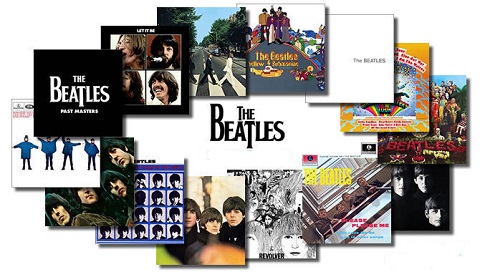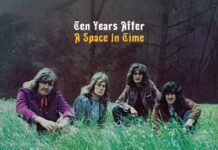As for what’s become available, the choices are quite fetching. Audiophiles purists, self-described completists, Beatlologists, and borderline anal-retentive types who have been screaming about superior mono mixes over what’s out and additional mono mixes of what’s not out, have finally gotten their wish. The Beatles In Mono box set features 10 albums in their original monaural mixes, plus a couple of discs worth of miscellaneous songs, including four from Yellow Submarine, also mixed in mono (think the Past Masters discs from 1987).
This is the first time mono mixes of Help!, Rubber Soul, Revolver, Sgt. Pepper’s Lonely Hearts Club Band, Magical Mystery Tour, and The Beatles have been released on CD. The original 1965 stereo mixes of Help! and Rubber Soul also make their debut on CD, following the mono mixes on their respective discs.
For the rest of us (and I count myself among them) where the stereo mixes are every bit as cool and coveted as the mono mixes, there’s some decision-making. You can get the 14-CD box set or choose any of the 14 titles individually. The individual discs are enhanced with QuickTime mini documentaries about the making of each album. Unless you get the box set, which has a DVD packed with all the mini documentaries, you’ll have to watch the video on your computer.
The individual discs are housed in colorful digipaks — eco-friendly packaging with its own advantages and disadvantages. It really comes down to whether you want to stare endlessly at the cover art or extract the CD from a tight-fitting pocket inviting future abrasion. The box set, by contrast, does a better job protecting the CD. Any shortcomings are more than compensated for with the liner notes and groves of new, unseen photos. The aesthetics politely put aside, let’s have a listen.
Remastering the Beatles catalog was an extensive and time-consuming process. It involved teams of recording, mastering and restoration engineers. After a series of tests, the original analog master tapes were transferred to digital with a Pro Tools workstation via an analog-to-digital converter. One song was transferred at a time, and tape heads were cleaned afterwards, but work on the actual audio was minimized to preserve “the original integrity of the songs.” Digital technology was employed to reduce noise sparingly, yet effectively, as well as to pump up the EQ and overall dynamics.
Logic would dictate one start from the beginning, but logic is overrated, especially these days, so instead, I went backwards and unwrapped Abbey Road. First released on Friday, September 26, 1969, Abbey Road would document the Beatles’ last stand in the studio. There is no question they went out on top by recording a tight and cohesive album. George Harrison contributed “Something” and “Here Comes The Sun,” arguably his two greatest songs. Both register incredibly big and bright on the remaster. To clearly hear the Moog synthesizer and guitar through the Leslie on “Because” and ‘Maxwell’s Silver Hammer” is a godsend. After an A/B comparison of the famed medley, I’m ready to sell off my 87 model and let the remaster guide the way.
Next up was the big daddy, The Beatles widely known as The White Album. The packaging of the remaster doesn’t quite match that of the 30th anniversary limited edition, which was far more true to the original LP. The tunes, however, are another story. Eric Clapton’s ax cries out a lead on “While My Guitar Gently Weeps,” and Paul McCartney’s bass is thumping everywhere like nobody’s business. It’s even impressive on “Martha My Dear.” The orchestration, the brass, the acoustic guitars — all given a face-lift. The syncopation and snorting may be frightening on “Piggies,” but the guitars on “Yer Blues” and “Helter Skelter” have never been more gutturally realized. So I peruse lyrics and recording notes in the booklet, pull out the mini Richard Hamilton collage (remembering my original full-size poster fell apart from over-folding) for a gaze, and think about Christmas 1968 when my parents gave me a new stereo and a fresh copy of The Beatles.
The booklet that comes with the Magical Mystery Tour remaster is reproduced from the original EP and subsequent Capitol LP. Like the 1987 CD, The songs replicate the Capitol version, which contained six songs from the Magical Mystery Tour TV show, and five additional tracks, including “Strawberry Fields Forever” and “Penny Lane.” All it took was one spin through the instrumental “Flying,” and a couple of clicks over to “I Am The Walrus,” and I knew this was a keeper.
The film and songs on Yellow Submarine fell somewhere between the period of The Beatles and Magical Mystery Tour; the soundtrack album wouldn’t appear until early 1969. Out of all the remasters, this may be the most expendable. The title track is on Revolver and “All You Need Is Love” is on Magical Mystery Tour. Which leaves four Beatles tracks and the film’s score, composed and orchestrated by George Martin. Harrison’s “Only A Northern Song” and “It’s All Too Much,” along with Lennon-McCartney’s “All Together Now” and “Hey Bulldog,” are good enough to make this record an essential piece of the puzzle.
Spending time with Rubber Soul and Revolver, one truly gets a sense of how the Beatles were developing as recording artists. Certainly, Help! is surging with growth — the title track and “You’ve Got Hide Your Love Away” are two of John Lennon’s most eloquent songs. That momentum would carry over to Rubber Soul where Lennon pulled away the blinds on “Norwegian Wood,” exorcised his demons on “Nowhere Man” and took a step back on “In My Life.”
The subtleties and nuances come alive on these two CDs. The sitar dances and leaps on “Norwegian Wood” but becomes more integral on the next album. Revolver would be the initial step away from the normal range of songs and sounds, utilizing a menagerie of ideas, effects, percussion devices and loops to spectacular effect. McCartney worked it on a few different fronts — going long with more sophisticated material like “Eleanor Rigby” and “For No One,” while turning out light-hearted fare such as “Good Day Sunshine” and “Got To Get You Into My Life” that sparkle with optimistic charm. Lennon was more intent on instilling a hallucinogenic spin via “She Said She Said,” “Doctor Robert” and “Tomorrow Never Knows.” Sequenced and stitched together, these songs gloriously parade a polish unmatched by even today’s high recording standards.
Following this progression, Sgt. Pepper’s Lonely Hearts Club Band is perched on top of the heap. This is the record that abandoned the organic glimmer of Revolver, but faithfully pushed the Beatles to grandiose heights of grandeur — clearly in need of addressing and direction at the dawn of 1967 and the Summer of Love. The fake band, as conceived by Paul McCartney, stayed at home while the craziness ensued. But the music rose to the challenge.
“Lucy In The Sky With Diamonds” and “Being For The Benefit Of Mr. Kite!” once again found Lennon pushing the bounds of imagination. “Within You Without You” whetted Harrison’s appetite for Indian music to a startling beautiful degree. For their one of their most ambitious statements, Lennon and McCartney married two pieces of music to create the epic “A Day In The Life.” To hear this one in all its pristine glory is truly a highlight of all the remasters.
Coming three years later, Let It Be fell short of the lofty expectations set forth by the likes of Revolver and Sgt. Pepper. In light of George Martin’s absence, Phil Spector’s unruly occupation and 2003’s Let It Be…Naked, the Let It Be remaster may be less desirable than other titles. If you can get through “The Long And Winding The Road,” however, the rest of the album includes some of the Beatles’ best bits on record. “Two Of Us” is still one of the great underrated collaborations between Lennon and McCartney. Spector’s embellishments aside, he managed to add a nice touch of strings to “Across The Universe” that reverberated swiftly in my headphones. The remastered CD’s mini documentary and historical notes also offer some keens insights into the Fabs’ dissolution.
There will undoubtedly be dissension among Beatle hardcores with regard to the mono mixes and stereo mixes. The new stereo mixes of Please Please Me, With The Beatles, A Hard Day’s Night and Beatles For Sale may be the line in the sand, but for the casual fan with a passing interest in the songs that put the group on the map, any one of these may do the trick. Here in the States, those first few albums were much different in appearance and content. Once the hardcores jump into the fray, it’s as if the Capitol versions never existed (unless you have an early copy of Yesterday And Today). On play back, you can definitely pick up on the differences between the 1987 monos and the stereo remasters. Which means, you can keep the old versions, upgrade to the stereo versions, and buy the mono box set for another perspective.
The double CD Past Masters combines the previous two Past Masters releases from 1987. The 32 songs are mostly miscellaneous A and B sides, none-album tracks that either fell between the cracks, missed soundtrack slots or simply didn’t fit anywhere else. Stacking hits like “She Loves You,” “I Want To Hold You Hand,” “Hey Jude” and “Revolution” with oddities like “Kom Gi Mir Deine Hand” (“I Want To Hold Your Hand” in German), “The Ballad Of John And Yoko” and “You Know My Name (Look Up The Number),” Past Masters is a template for everything right and just about the Beatles and their place in history.
Future mongers and format naysayers may have their opinions on fanciful CD packages like the 2009 Remasters in the age of the digital download. Indeed, as numbers increase for the convenience and impersonality that come with the iTunes lifestyle, remastering CD collections like this could become an obsolete practice. Can one sonically asphyxiated by the low fidelity of an MP3 ever learn to love the superior sound and accouterments associated with the CD? Perhaps the Beatles’ 2009 Remasters can show the way…
~ Shawn Perry




















